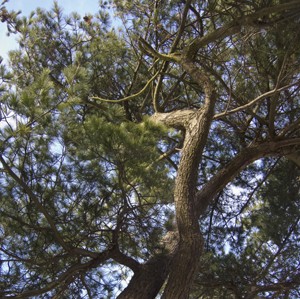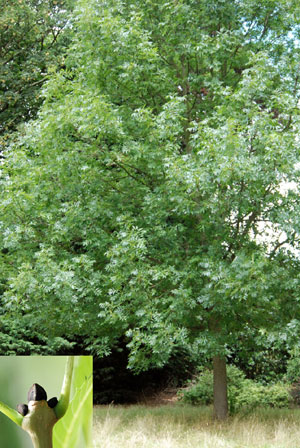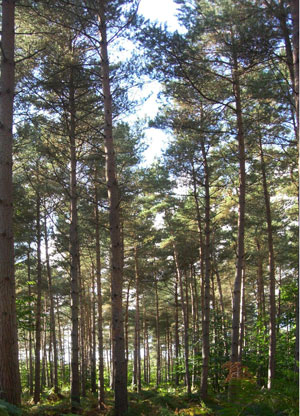Monitoring and improving the health of our trees

Our trees, woodlands and forests are facing a variety of challenges to their well being, ranging from the changing (and rather variable) nature of our climate (extreme events), habitat fragmentation, the introduction of non-native species (sycamore, turkey oak) and ‘new’ pathogens and pests (some airborne, some travelling on imported plants). Fortunately, there are also a number of people and organisations who are working on ways to address these challenges.
At the Centre for Ecology and Hydrology, Dr Stephen Cavers, is the leader of the PROTREE project . Using the Scots Pine as a “representative” of our native tree species, it will look at the following threats / pathogens :-
- red band needle blight fungus
- pine tree lappet moth
- pine pitch canker fungus
PROTREE will try to determine if the genetic variation of the Scots Pine offers any protection against these organisms, and whether the pine populations can adapt. The project will also try to integrate its findings into practical information / techniques for the management of trees / woodlands / forests. With Scots Pine as a model, the hope is that it will offer a protocol that will apply to other tree species (and allow the development of an online database).
 At the John Innes Centre (in Norwich), Professor James Brown is looking at the Ash die back fungus (Chalara); his work focuses on the pathogenicity of different strains of the fungus. That is, how much damage different forms of the fungus do to ash trees (rather like different strains of flu have different effects on us). If the fungus exhibits considerable genetic variation then it is more likely to be able to ‘breach’ the defences that Ash trees might offer. An understanding of the genetic make-up of the fungus might offer a pathway to breeding more resistant ash trees, or the development of management techniques that could ‘encourage’ the spread of disease resistant genes.
At the John Innes Centre (in Norwich), Professor James Brown is looking at the Ash die back fungus (Chalara); his work focuses on the pathogenicity of different strains of the fungus. That is, how much damage different forms of the fungus do to ash trees (rather like different strains of flu have different effects on us). If the fungus exhibits considerable genetic variation then it is more likely to be able to ‘breach’ the defences that Ash trees might offer. An understanding of the genetic make-up of the fungus might offer a pathway to breeding more resistant ash trees, or the development of management techniques that could ‘encourage’ the spread of disease resistant genes.
At Queen Mary, University of London, Dr. Richards Buggs is adopting a different approach - looking at the genetic make up of the Ash species. The DNA sequence of the Ash (its genome) has already been established. Close ‘relatives’ of the Ash are not troubled by the fungus; it is known that in Manchuria the fungus has been around for a long time and living trees are not affected. It may be that once disease resistance genes are identified that they could be transferred to the European Ash (either by conventional breeding techniques or through GM (genetic modification) technology.
Over at Swansea Univeristy, Professor Tariq Butt, who works on biological control, is looking at a fungus that is a specialist killer of insects (Metarhizum anisopliae) , with a view to controlling insect pests - like the pine processionary moth. The spores of this fungus germinate on the body of insect hosts, penetrate the exoskeleton / cuticle and grow throughout the body - killing the insect. The caterpillars of the processionary moth (found across Europe, but not the UK as yet [but see comment below]) are responsible for extensive damage to pines, feeding on the needles, stunting growth and reducing timber yield. Also, these caterpillars are covered in stinging hairs, which can detach and cause swelling and intense pain, particular if they lodge in the eyes.
A different approach is being adopted at Stirling University, where Dr Adam Kleczkowski is heading up a varied team of ecologists, mathematicians and economists who are looking at the forces affecting the spread of pathogens, and how the decision-making processes of forestry / woodland management are affected. The aim is to produce a list of ‘anti-disease' policies, ranked by cost effectiveness. Another inter-disciplinary team is to be found at FERA (Food and Environment Agency), led by Dr Rick Mumford - this group is working on technologies that may stop pests and pathogens at the ‘points of entry’ - ports, where various plants pass through on their journey from foreign parts.. Two technologies are presently available
- a. an electronic ‘nose’ (sniffer technology) that detects volatile chemicals emitted by infected plants
- b. Cameras that can detect disease induced changes to foliage etc. before it can be detected by the ‘naked eye. Other technologies are in development.
The public understanding of risks to trees and woodlands is being investigated at Imperial College by Dr Clive Potter - with a view to the better communication of the problems associated with these pests and pathogens, why they are relevant to all and how all can help make a difference.
Comments are closed for this post.
Discussion
Good summary above but a corection and addition :-
The processionary moth mentioned above has arrived in the UK – its in woodland in Pangbourne, Berks and also in Kent.
Dr. Sandra Denman at Forest Research, Alice Holt, Hampshire is heading up a team investigating the causes of Acute Oak Dieback caused by the agrilus beetle. For further information about this see http://oxfordshirewoodlandgroup.co.uk/forum/?mingleforumaction=viewtopic&t=124


An excellent article highlighting the varied approaches to combating the influx of new pests & diseases attacking our trees & ultimately our landscape. As a volunteer for the Woodland Trust I took up their offer of attending one of their training sessions on tree health (Observatree). We all need to become aware of this increasing problem.
Ashley
3 October, 2015